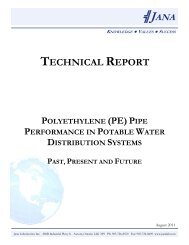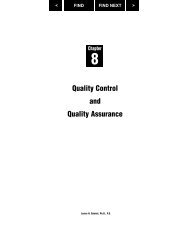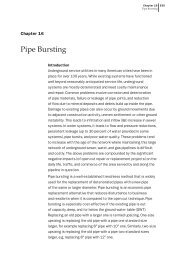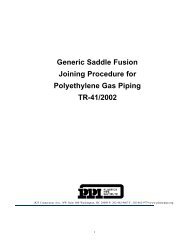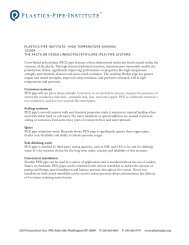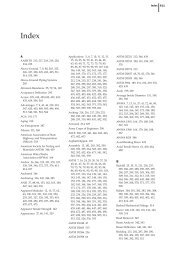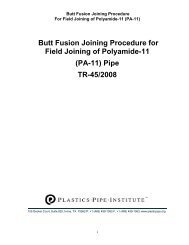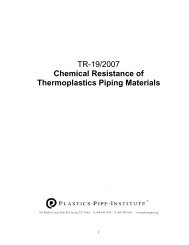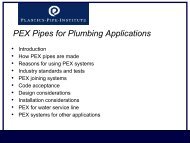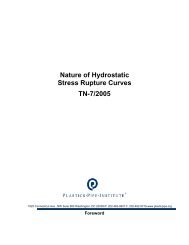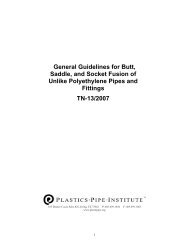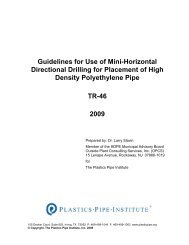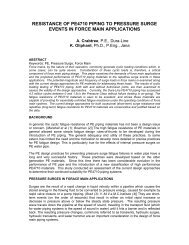TR-34: Disinfection of Newly Constructed Polyethylene Water Mains
TR-34: Disinfection of Newly Constructed Polyethylene Water Mains
TR-34: Disinfection of Newly Constructed Polyethylene Water Mains
You also want an ePaper? Increase the reach of your titles
YUMPU automatically turns print PDFs into web optimized ePapers that Google loves.
Foreword<br />
This report was developed and published with the technical help and financial<br />
support <strong>of</strong> the members <strong>of</strong> Plastics Pipe Institute, PPI. The members have shown<br />
their interest in quality products by assisting independent standards-making and<br />
user organizations in the development <strong>of</strong> standards, and also by developing<br />
reports on an industry-wide basis to help engineers, code <strong>of</strong>ficials, specifying<br />
groups, and users.<br />
The intent <strong>of</strong> this technical report is to provide information on the effects <strong>of</strong><br />
chlorine disinfection on the durability <strong>of</strong> PE piping for water systems. The testing<br />
reported herein was conducted on service pipe sizes and on resins in the form <strong>of</strong><br />
plaques in accordance with the various test methods employed. At the time the<br />
testing was conducted, high performance PE materials such as PE4710 were not<br />
available. In 2006, PPI established a new program to provide test information on<br />
high performance PE materials, and will update this report when the information<br />
is available.<br />
Tests on piping in this report were conducted on service sizes; however, larger<br />
PE pipes produced to AWWA C901 and AWWA C906 are subject to the identical<br />
water service design criteria and in-service operating stresses. Furthermore,<br />
chlorine resistance tests <strong>of</strong> other olefin materials such as PEX have<br />
demonstrated that tests <strong>of</strong> service sizes are representative <strong>of</strong> larger sizes.<br />
Therefore, the test results herein are expected to be representative <strong>of</strong> larger<br />
sizes.<br />
This report has been prepared by PPI as a service <strong>of</strong> the industry. The<br />
information in this report is <strong>of</strong>fered in good faith and believed to be accurate at<br />
the time <strong>of</strong> its preparation, but is <strong>of</strong>fered without any warranty, expressed or<br />
implied, including WARRANTIES OF MERCHANTABILITY AND FITNESS FOR<br />
A PARTICULAR PURPOSE. Any reference to or testing <strong>of</strong> a particular<br />
proprietary product should not be construed as an endorsement by PPI, which<br />
does not endorse the proprietary products or processes <strong>of</strong> any manufacturer.<br />
The information in this report is <strong>of</strong>fered for consideration by industry members in<br />
fulfilling their own compliance responsibilities. PPI assumes no responsibility for<br />
compliance with applicable laws and regulations.<br />
PPI intends to revise this report from time to time, in response to comments and<br />
suggestions from users <strong>of</strong> the report. Please send suggestions <strong>of</strong> improvements<br />
to the address below. Information on other publications can be obtained by<br />
contacting PPI directly or visiting the web site.<br />
The Plastics Pipe Institute<br />
http://www.plasticpipe.org<br />
(Editorial Revisions, February 2007)<br />
2




